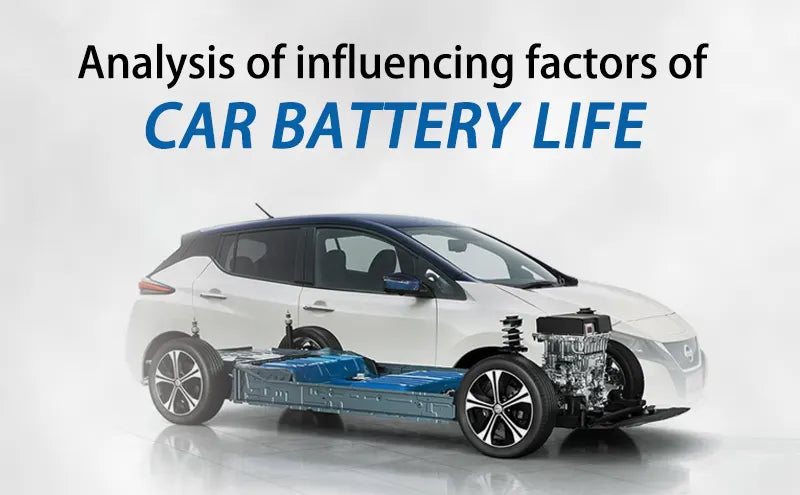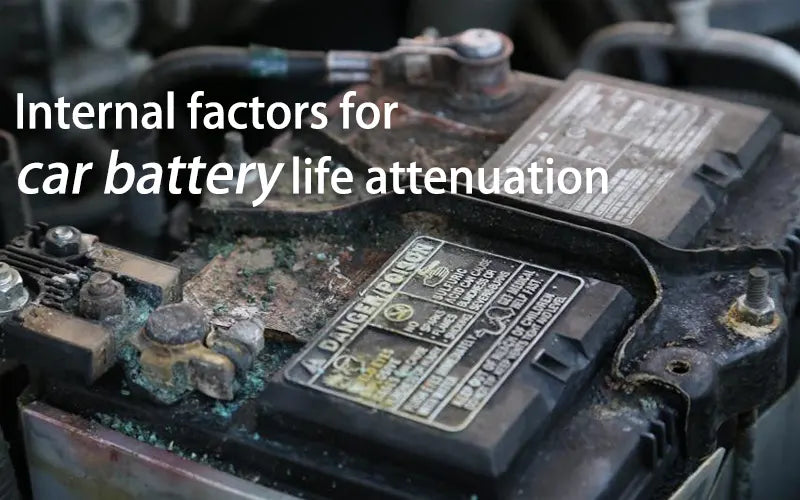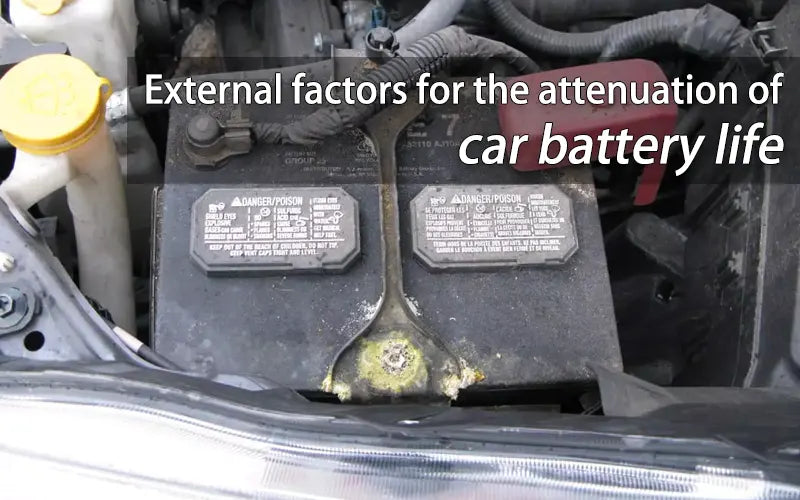
Main content:
- Factors that affect car battery life
- Use habits influence car battery life
- Internal factors for car battery life attenuation
- Aging of cathode materials
- Aging of anode materials
- Electrolyte decomposition
- Separator and current collectors
- External factors for the attenuation of car battery life
- Different charge and discharge depths
- Conclusion
As an important part of EV, car batteries are used in pure electric vehicles, hybrid vehicles and fuel cell vehicles. However, the car battery life will be affected by the different driving habits and environment of the car, showing a multi-factor attenuation process.
In the industrial chain of EV, the need for battery health assessment is extensive. Due to the many factors affecting the decay of car battery life, it presents great challenges to the assessment of battery health status.
This article will sort out the key factors affecting battery life from both internal and external aspects, reveal the mechanism of action of many factors, and help evaluate the performance design and life of future power batteries.
1. Factors that affect car battery life
Factors affecting the life of lithium-ion batteries are complex. First of all, car battery life is determined by the quality of the battery itself, and the design of the electrode sheet and internal structure will affect the car battery life.
Although the quality of the battery itself is basically determined at the factory, it will also have an impact on the service life of the car battery. By further understanding and comparing the top 10 lithium battery companies in the world, we can find the battery with the best battery life.
2. Use habits influence car battery life
Such as driving habits, charging and discharging habits and range, operating mileage, ambient temperature and terrain will affect the physical quantity of battery work. And the physical quantity indicators of these battery working conditions like working temperature, charge and discharge rate, etc. will affect the attenuation process of car battery life.

The reasons for the attenuation of car battery life include SEI film growth or decomposition, electrolyte decomposition, binder aging, graphite cathode shedding, which will lead to a decrease in the active lithium of the battery, a decrease in the activity of the cathode and anode.
Even increase the blocking of the lithium ion transport channel, and finally a decrease in the usable capacity of the battery. Therefore, car battery life is determined by the internal reaction of the battery and the external environment.
3. Internal factors for car battery life attenuation
① Aging of cathode materials
The cathode material is the main source of active lithium, and lithium ions are removed from the cathode material during charging and returned to their original position when discharged.
The ejection and intercalation of lithium ions cause volume changes in the cathode material. When this change is in a recoverable state, it does not affect normal work, but when irreversible deformation occurs for some reason, it will affect the normal removal and intercalation of lithium ions, affecting capacity play.
● Lithium cobalt oxide material
When the lithium cobalt oxide cathode operates for a long time or a short-term overcharge occurs, lithium ion overdumping may occur.
When cobalt ions occupy the position of lithium ions, it will cause the material's layer spacing to become smaller. This affects the diffusion of lithium ions in the material and affects cathode performance.

● Lithium iron phosphate
There are phosphorus-rich and iron-rich phases on the surface of lithium iron phosphate cathode materials, and the corrosion of iron-rich and phosphorus-rich phases will deviate from normal materials.
This will result in different corrosion rates of lithium iron phosphate materials in different positions, and the performance of lifepo4 batteries decays at different rates.
● Ternary lithium material
During the loading and unloading process of ternary materials, the crystal lattice of the material repeatedly expands, which may lead to structural collapse after long-term cycling and deterioration of material properties.
At the same time, lithium-nickel mixing may occur inside the structure of the material, which will reduce its specific discharge capacity.
② Aging of anode materials
The working order of lithium ions in the anode material is opposite to that of the cathode material. They are embedded in the anode when charging, and detached from the it when discharged, and the charging and discharging processes are also accompanied by volume changes.
The most commonly used graphite anode, mainly lithium ions, is embedded and detached in the layered graphite structure, causing volume changes in the process. The type of alloying reaction, accompanied by a larger volume expansion, leads to a faster deterioration of the properties of the material.

Therefore, at present, this type of material is mostly used in a composite state with graphite. In addition, the cathode forms an SEI film at the beginning of formation. SEI membrane can reduce the interface reaction rate of graphite anode and electrolyte, consume the amount of active lithium ions, and reduce the activity of cathode.
The most important function of lithium ion electrolyte is to conduct lithium ions, followed by improving interfacial contact. Lithium ion electrolyte is mainly composed of lithium salts, solvents, and functional additives.
③ Electrolyte decomposition
● Lithium hexafluorophosphate(LiPF6)
Lithium hexafluorophosphate is the most commonly used lithium salt, but its stability is not ideal. In addition, the electrolyte is very sensitive to moisture, and it will absorb moisture and break down when encountering a trace amount of water.
● Hydrofluoric acid(HF)
Hydrofluoric acid is highly corrosive and will corrode electrodes, current collectors, SEI films, etc., accelerating the decline in battery performance.
Commonly used solvents for lithium ion battery electrolytes include carbonate solvents, which have weak oxidation resistance. Oxidative decomposition to generate water during local overpressure or short-term overcharge will promote the decomposition of lipf6, forming a series of side reactions.
④ Separator and current collectors
● The principle of seperator
The separator plays the role of electronic insulation and ion conduction in lithium ion batteries. Therefore, the diaphragm must have sufficient electronic insulation performance, and there must be sufficient and evenly distributed pores to provide a channel for lithium ion diffusion.
At the same time, the diaphragm needs to ensure a certain level of mechanical strength and thermal stability, and in order to improve energy density, it is also necessary to reduce the thickness as much as possible.

● Effects of seperator
In the operation of the battery, the products of various side reactions will be deposited on the pole piece and separator, blocking the pores of the separator and causing the internal resistance to rise, affecting the capacity.
Temperature changes in the external environment during battery operation may also cause the separator to expand and contract, affecting the size and porosity of the separator.
● The principle of current collection
Current collectors commonly used for the cathode and anode of lithium-ion batteries are aluminum foil and copper foil. They should maintain good contact with the electrode and conduct electrons in a timely manner.
● The effect of current collectors
During the use of the battery, the pressure inside the battery will also increase, which easily causes the current collection contact area to decrease. The electrolyte also has a certain corrosive effect on the current collector, which will cause poor contact.
And even local lithium precipitation may occur. In addition, when the battery is overcharged, copper ions will be removed and copper precipitation will appear on the surface of the anode, affecting the contact between the copper collector and the electrode. There is also the possibility of a copper dendrite penetrating the diaphragm, affecting battery performance and safety.
4. External factors for the attenuation of car battery life
● Temperature
The most suitable working temperature for lithium-ion batteries is about 25 °C.

- High temperature
At high temperatures, the activity of the entire chemical system increases, and the rate of side reactions will increase accordingly, but the side reaction is irreversible. In addition, the high temperature decomposition of the electrolyte will also produce gas, causing the battery to swell and the interface contact to deteriorate.
- Low temperature
At low temperatures, the activity of the entire chemical system decreases, and relatively extreme situations are prone to occur, resulting in an increased probability of low-temperature lithium precipitation.
● Cycles and consistency
The battery system is integrated by a large number of single cells, and the capacity of the battery depends on the worst performing cells in the battery system, so the consistency of the battery is critical to the performance of the battery.
As batteries age, inconsistencies get worse. In addition, the attenuation law of battery capacity with the number of cycles does not change linearly, and there is generally a phenomenon of gentle attenuation in the early stage and accelerated attenuation in the later stage. At this time, as long as a battery has a rapid decay, the entire battery system will show the same decay trend.
5. Different charge and discharge depths
● Charge and discharge range
The battery charge and discharge interval is an important factor affecting car battery life, and when the same battery is cycled at different charge and discharge intervals, the cycle life may be significantly different. The car battery voltage rises and the charger voltage will also rise. When the set voltage rises, the charger voltage stops rising. The charging current will be lower than the set current.

The battery is in an unstable state when fully charged and empty, and the rate of side reactions of the chemical system inside the battery increases. The relationship between different charge and discharge depths and car battery life The large charge-discharge interval refers not only to very high SOCs, but also to the risk of increased failure at very low SOCs.
Under very high or very low SOC, due to factors such as preparation, diffusion conditions, temperature, etc., the performance degradation of the electrode sheet is caused by local overdischarge or overcharge.
In the critical SOC state, the risk of local areas exceeding the battery safety limit is greater, and the risk of overcharging and overdischarging is more likely to occur. Therefore, the battery management system generally leaves a certain amount of safety redundancy, according to the software and hardware conditions.
● Charge-discharge ratio
The larger the charge and discharge rate of the battery, the faster its cycle life decays, and the main reasons include the following:- Large rate charges and discharges can produce lithium evolution on the surface of the cathode.
- Large rate charge and discharge will cause greater polarization, so that the side reaction rate of materials such as electrolytes is accelerated.
- A large charge and discharge rate will increase the battery's temperature, and the side reaction rate will be accelerated.
After lithium precipitation occurs in the large rate charge and discharge cycle, even if the small rate is used for complete discharge, there will still be lithium precipitated on the surface of the graphite anode.
6. Conclusion
The importance of car battery life evaluation from the perspective of the entire battery industry chain, and summarizes the internal and external factors affecting the attenuation of car battery life.
The specific operating conditions of the user connection will affect the physical quantity and side reactions of the battery operation, and eventually lead to the process of car battery life degradation. Comprehensive analysis, car battery life attenuation is determined by internal and external factors.
The external use conditions of the battery include ambient temperature, driving road conditions, a charging and discharging system, etc., which will gradually accelerate the internal side reaction during battery use and threaten the car battery life.
Related articles: Top 10 golf cart battery companies, battery self discharge, car battery recycling
















